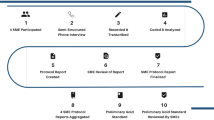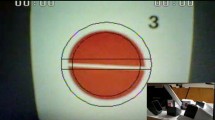Abstract
Background
Learning an advanced laparoscopic procedure is a complex process that requires clinical exposure, direct teaching, and deliberate practice. Expert surgeons automate their knowledge, making it difficult to teach incremental steps. Our aim was to deconstruct the steps of a laparoscopic Nissen fundoplication (LNF) and develop a procedural checklist assessment instrument.
Methods
A behavioral task analysis was conducted with five experts using the Delphi technique to identify all steps of a LNF. The Delphi survey included video analysis of expert performance, two electronic iterative rounds and final group interview to reach consensus. The created checklist was then used to assess the performance of 14 general surgery residents. Participants viewed a brief instructional video and performed a LNF on a porcine model. Laparoscope video recordings were evaluated by a blinded investigator using the created LNF checklist.
Results
The task analysis produced a 65-step procedural checklist with six major components (patient positioning and port placement, dissection of crura and esophagus, closure of crura, mobilization of fundus, orientation of fundoplication, and creation of fundoplication). Thirteen of 14 participants completed the procedure. Median score for all residents was 31 (range 13–38) with senior residents (36, 34–38) having significantly higher scores than junior residents (30, 13–36) (p = 0.0162). Most residents attempted the major components of the procedure; 13 of 14 dissected the crura and created the fundoplication, 12 closed the crura, and 11 mobilized the fundus. However, residents frequently failed to complete key elements such as protection of the vagus nerve or mediastinal mobilization of the esophagus.
Conclusions
The task analysis and Delphi technique was successful in reaching expert consensus on the procedural steps of a LNF and in creating a valid checklist. By capturing automated knowledge in a checklist form, we can scaffold resident learning and improve feedback for an advanced laparoscopic case.
Similar content being viewed by others
References
Williams RG, Verhulst S, Colliver JA, Dunnington GL (2005) Assuring the reliability of resident performance appraisals: more items or more observations? Surgery 137(2):141–147
Norman G, Eva K, Brooks L, Hamstra S (2006) Expertise in medicine and surgery. In: Ericsson K, Charness N, Feltovich P, Hoffman R (eds) The Cambridge handbook of expertise and expert performance. Cambridge University Press, New York, pp 339–354
Feltovich P, Prietula M, Ericsson K (2006) Studies of expertise from psychological perspectives. In: Ericsson K, Charness N, Feltovich P, Hoffman R (eds) The Cambridge handbook of expertise and expert performance. Cambridge Unversity Press, New York, pp 41–68
Kopta J (1971) An approach to the evaluation of operative skills. Surgery 70:297–303
Lossing A, Gretsch G (1992) A prospective controlled trial of teaching basic surgical skills with 4th year medical students. Med Teacher 14:49–52
Winckle C, Reznick R, Cohen R, Taylor B (1994) Reliability and construct validity of a structured technical skills assessment form. Am J Surg 167:423–427
Lippert F, Farmer JA (1984) Psychomotor skills in orthopedic surgery. Williams & Walkins, Baltimore, MD
Reznick R, Regehr G, MacRae H et al (1997) Testing technical skill via an innovative “bench station” examination. Am J Surg 173(3):226–230
Brasel KJ, Bragg D, Simpson DE, Weigelt JA (2004) Meeting the Accreditation Council for Graduate Medical Education competencies using established residency training program assessment tools. Am J Surg 188(1):9–12
Gumbs A, Hogle N, Fowler D (2007) Evaluation of resident laparoscopic performance using global operative assessment of laparoscopic skills. J Am Coll Surg 204(2):308–313
Beard J, Choksy S, Khan S (2007) Assessment of operative competence during carotid endarterectomy. Br J Surg 94(6):726–730.
Goodman C (1987) The Delphi technique: a critique. J Adv Nurs 12:729–734
Sullivan ME, Ortega A, Wasserberg N et al (2008) Assessing the teaching of procedural skills: can cognitive task analysis add to our traditional teaching methods? Am J Surg 195(1):20–23
Luker KR, Sullivan ME, Peyre SE et al (2008) The use of a cognitive task analysis-based multimedia program to teach surgical decision making in flexor tendon repair. AM J Surg 195(1):11–15
Sullivan ME, Brown CVR, Peyre SE et al (2007) The use of cognitive task analysis to improve the learning of percutaneous tracheostomy placement. Am J Surg 193(1):96–99
Author information
Authors and Affiliations
Corresponding author
Additional information
Presented as an oral presentation during the 2008 Annual SAGES Meeting April 11, 2008.
Appendix: Final instrument
Appendix: Final instrument
Laparoscopic Nissen fundoplication procedural checklist
Please indicate if the procedural steps listed below were performed during the observed laparoscopic Nissen fundoplication | Done | Not done | ||
|---|---|---|---|---|
Patient positioning and port insertion | ||||
1 | R | Place patient in dorsal lithotomy position | 1 | 0 |
2 | R | Reverse Trendelenburg to about 30° | 1 | 0 |
3 | R | Camera—insert port one-third from the umbilicus to xiphoid just left of midline | 1 | 0 |
4 | R | Examine abdomen—search for abnormal pathology, injuries from port placement | 1 | 0 |
5 | R | Surgeon’s left hand—insert port at right subcostal margin, mid axillary line | 1 | 0 |
6 | R | Surgeon’s right hand—insert port at left subcostal, mid axillary line | 1 | 0 |
7 | R | Assistant retractor—insert port at left anterior axillary line, level of umbilicus | 1 | 0 |
8 | R | Liver retractor—insert port at subxiphoid or at right anterior axillary line at level of umbilicus | 1 | 0 |
9 | R | Visualize insertion of trocars | 1 | 0 |
Exposure of the crura | ||||
10 | E | Retract left lobe of liver anteriorly and towards the patient’s right | 1 | 0 |
11 | R | Assistant retract stomach towards left foot | 1 | 0 |
12 | R | Distract gastrohepatic ligament on tension | 1 | 0 |
13 | E | Incise gastrohepatic ligament (cautery or harmonic) | 1 | 0 |
14 | E | Identify right crus | 1 | 0 |
15 | R | Score right crus | 1 | 0 |
16 | E | Dissect right crus from esophagus | 1 | 0 |
17 | R | Assistant retract stomach caudally and posteriorly | 1 | 0 |
18 | E | Dissect anterior aspect of esophagus from crus | 1 | 0 |
19 | E | Identify/protect anterior vagus nerve | 1 | 0 |
20 | R | Assistant retract stomach caudally and to the right | 1 | 0 |
21 | E | Identify left crus | 1 | 0 |
22 | R | Score left crus | 1 | 0 |
23 | E | Dissect left crus from esophagus | 1 | 0 |
24 | E | Dissect posteriorly down left crus towards crural decussation | 1 | 0 |
25 | E | Dissect fundus from left crus | 1 | 0 |
Continue with crural dissection or jump to fundic mobilization and return here after | ||||
26 | R | Assistant regrasp near gastroesophageal junction and retract anteriorly and to the left | 1 | 0 |
27 | E | Complete dissection of right crus down to inferior crural decussation | 1 | 0 |
28 | E | Identify/protect posterior vagal nerve | 1 | 0 |
29 | E | Develop posterior esophageal window | 1 | 0 |
30 | R | Pass Penrose drain through created window to use as retractor | 1 | 0 |
31 | R | Secure both Penrose tails together with endoloop | 1 | 0 |
32 | R | Assistant retract esophagus with Penrose anteriorly and to the left | 1 | 0 |
33 | E | Complete posterior window and left and right crural dissection | 1 | 0 |
34 | E | Dissect into mediastinum around esophagus to obtain a minimum of 2 cm intra-abdominal length | 1 | 0 |
35 | O | Develop second window between posterior vagus and esophagus | 1 | 0 |
36 | O | Pass a second Penrose through this new window | 1 | 0 |
37 | O | Secure both tails of second Penrose together with endoloop and remove first Penrose | 1 | 0 |
Closure of the crura | ||||
38 | R | Place multiple figure-of-8 or mattressed sutures to close crura | 1 | 0 |
39 | R | Place most inferior suture first and proceed anteriorly | 1 | 0 |
40 | E | Complete all sutures now or add last suture after creation of fundoplication | 1 | 0 |
Mobilization of the fundus | ||||
41 | R | Suspend gastrosplenic omentum between assistant’s retractor and surgeon’s left hand | 1 | 0 |
42 | R | Pick a point one-third down the greater curve to incise gastrosplenic omentum | 1 | 0 |
43 | R | Sequentially ligate short gastric arteries moving towards gastroesophageal junction | 1 | 0 |
44 | R | Dissect any posterior fundic gastric attachments | 1 | 0 |
45 | R | Complete dissection of any remaining gastric attachments to crus or diaphragm | 1 | 0 |
Configuration of the fundoplication | ||||
46 | R | Retract greater curve of stomach anteriorly towards liver | 1 | 0 |
47 | R | Measure 6 cm along greater curvature from gastroesophageal junction and 2 cm in from the edge of the curvature down the posterior fundic wall | 1 | 0 |
48 | O | Mark this location with a loosely tied 3–0 silk suture | 1 | 0 |
49 | E | Pass suture and posterior fundic wall of stomach through posterior esophageal window | 1 | 0 |
50 | E | Grasp anterior fundic wall of stomach and drag anteriorly towards patient’s right | 1 | 0 |
51 | E | Kissing/shoeshine maneuver to orient fundoplication into final position—fundic edges meet on right side without twisting and with short gastrics in natural position | 1 | 0 |
Fixation of the fundoplication | ||||
52 | E | Relax Penrose retraction of gastroesophageal jxn | 1 | 0 |
53 | E | Pass 60-French bougie | 1 | 0 |
54 | E | Reconfirm configuration of wrap | 1 | 0 |
55 | R | Insert first suture into abdominal cavity—a double armed, pledgeted suture | 1 | 0 |
56 | R | Pass first suture (first needle) through anterior fundus then esophagus at 11 o’clock then posterior fundus | 1 | 0 |
57 | R | Pass second arm of first suture as above | 1 | 0 |
58 | R | Place second pledget and tie | 1 | 0 |
59 | R | Pass second suture through anterior fundus then posterior fundus cranial to first suture | 1 | 0 |
60 | R | Pass third suture through anterior fundus then posterior fundus caudal to first suture | 1 | 0 |
61 | R | Remove bougie | 1 | 0 |
62 | R | Examine crural closure, insert final suture to a gap of approximately 1–2 fingerbreadths | 1 | 0 |
63 | E | Remove Penrose retractor | 1 | 0 |
64 | R | Pass nasogastric tube | 1 | 0 |
65 | E | Remove ports under direct visualization and close ports sites | 1 | 0 |
Rights and permissions
About this article
Cite this article
Peyre, S.E., Peyre, C.G., Hagen, J.A. et al. Laparoscopic Nissen fundoplication assessment: task analysis as a model for the development of a procedural checklist. Surg Endosc 23, 1227–1232 (2009). https://doi.org/10.1007/s00464-008-0214-4
Received:
Accepted:
Published:
Issue Date:
DOI: https://doi.org/10.1007/s00464-008-0214-4




